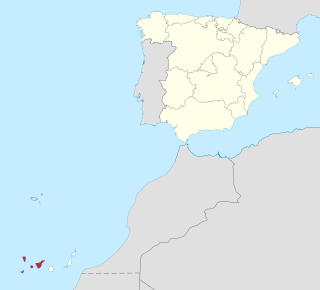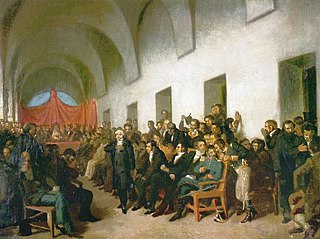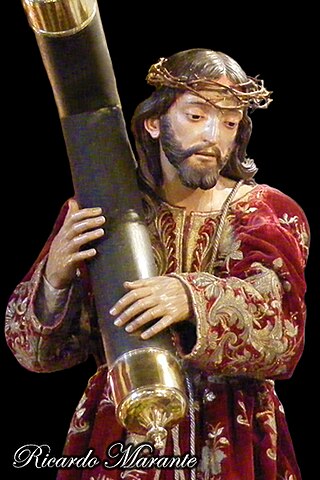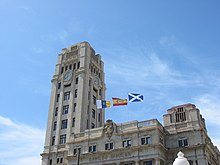
The Canary Islands, also known informally as the Canaries, are a Spanish autonomous community and archipelago in Macaronesia in the Atlantic Ocean. At their closest point to the African mainland, they are 100 kilometres west of Morocco and the Western Sahara. They are the southernmost of the autonomous communities of Spain. The islands have a population of 2.2 million people and are the most populous special territory of the European Union.

Province of Santa Cruz de Tenerife, also Province of Santa Cruz, is a province of Spain, consisting of the western part of the autonomous community of the Canary Islands. It consists of about half of the Atlantic archipelago: the islands of Tenerife, La Gomera, El Hierro, and La Palma. It occupies an area of 3,381 km2 (1,305 sq mi). It also includes a series of adjacent roques.

La Gomera is one of Spain's Canary Islands, in the Atlantic Ocean off the coast of Africa. With an area of 370.03 km2 (142.87 sq mi), it is the third-smallest of the archipelago's eight main islands. It belongs to the province of Santa Cruz de Tenerife. La Gomera is the third least populous of the eight main Canary Islands, with 22,361 inhabitants at the start of 2023. Its capital is San Sebastián de La Gomera, where the cabildo insular is located.

Gran Canaria, also Grand Canary Island, is the third-largest and second-most-populous island of the Canary Islands, an archipelago off the Atlantic coast of Northwest Africa and is part of Spain. As of 2023 the island had a population of 862,893 that constitutes approximately 40% of the population of the archipelago. Las Palmas de Gran Canaria, the capital of the island, is the biggest city of the Canary Islands and the ninth of Spain.

Tenerife is the largest and most populous island of the Canary Islands. It is home to 42.9% of the total population of the archipelago. With a land area of 2,034.38 square kilometres (785.48 sq mi) and a population of 948,815 inhabitants as of January 2023, it is also the most populous island of Spain and of Macaronesia.

Santa Cruz de Tenerife, commonly abbreviated as Santa Cruz, is a city, the capital of the island of Tenerife, Province of Santa Cruz de Tenerife, and one of the capitals of the Canary Islands, along with Las Palmas. Santa Cruz has a population of 206,593 (2013) within its administrative limits. The urban zone of Santa Cruz extends beyond the city limits with a population of 507,306 and 538,000 within urban area. It is the second largest city in the Canary Islands and the main city on the island of Tenerife, with nearly half of the island's population living in or around it.

A cabildo insular is the government and administration institution of each of the seven major islands in the Canary Islands archipelago: Tenerife, Fuerteventura, Gran Canaria, Lanzarote, La Palma, La Gomera and El Hierro. The island of La Graciosa falls under the jurisdiction of the cabildo of Lanzarote.

Candelaria, also Villa Mariana de Candelaria, is a municipality and city in the eastern part of the island of Tenerife in the Province of Santa Cruz de Tenerife, in the Canary Islands, Spain. The city is located on the coast, 17 km southwest of Santa Cruz de Tenerife. The population is 25,140 (2010), and the area is 49.18 km².

A cabildo or ayuntamiento was a Spanish colonial and early postcolonial administrative council that governed a municipality. Cabildos were sometimes appointed, sometimes elected, but were considered to be representative of all land-owning heads of household (vecinos). The colonial cabildo was essentially the same as the one that was developed in medieval Castile.

The Tenerife Arts Space is a cultural space and building in Santa Cruz de Tenerife, Tenerife, Spain. Opened in 2008, it was designed by Herzog & de Meuron and Virgilio Gutierrez. It houses a permanent exhibition of the works of Óscar Domínguez, as well as the Biblioteca Municipal de Santa Cruz de Tenerife, and the Centro de Fotografía Isla de Tenerife. It is operated by the Cabildo de Tenerife.

The Auditorio de Tenerife "Adán Martín" is an auditorium in Santa Cruz de Tenerife, Canary Islands, Spain. Designed by architect Santiago Calatrava, it is located on the Avenue of the Constitution in the Canarian capital, and next to the Atlantic Ocean in the southern part of Port of Santa Cruz de Tenerife. Construction began in 1997 and was completed in 2003. The auditorium was inaugurated on 26 September of that year in the presence of Felipe, Prince of Asturias, and was later visited by former U.S. President Bill Clinton. The building is framed within the tenets of late-modern architecture of the late 20th century.
Juan Leal Goraz, also called Juan Leal Gonzal, was a Spanish settler and politician who served as the first alcalde of La Villa de San Fernando, which later would become the city of San Antonio, Texas. A native of the Canary Islands, Leal went to San Antonio in 1731 leading a group of settlers from the Canary Islands to populate this municipality, founded by the Spanish government under the sponsorship of King Philip V. Leal had asserted himself as the Canarian emigrants' leader and spokesman since they left the islands. He served as alcade of San Antonio between 1731 and 1732, and again in 1735.

The 2015 Spanish local elections were held on Sunday, 24 May 2015, to elect all 67,515 councillors in the 8,122 municipalities of Spain and all 1,040 seats in 38 provincial deputations. The elections were held simultaneously with regional elections in thirteen autonomous communities, as well as elections in the three foral deputations of the Basque Country, the four island councils in the Balearic Islands and the seven island cabildos in the Canary Islands.

The 1983 Spanish local elections were held on Sunday, 8 May 1983, to elect all 67,505 councillors in the 7,781 municipalities of Spain and all 1,024 seats in 38 provincial deputations. The elections were held simultaneously with regional elections in thirteen autonomous communities, as well as local elections in the three foral deputations of the Basque Country and the ten island councils in the Balearic and Canary Islands.

The Province of Canary Islands is the name of the former province formed by the Canary Islands. This province had its capital in the city of Santa Cruz de Tenerife. After the provincial division in 1927, this province was composed of the province of Santa Cruz de Tenerife that encompassed the western islands of the Canaries, while the province of Las Palmas covered the eastern islands.

Palacio Insular de Tenerife is a building in the Spanish city of Santa Cruz de Tenerife, home of the Cabildo de Tenerife. Designed by the architect José Enrique Marrero Regalado, and executed between 1935 and 1940, it is located in the Plaza de España. The building stands out for its tower topped by a clock commissioned in 1950 and is one of the most recognizable symbols of the city of Santa Cruz de Tenerife.

Holy Week is commemorated each year in Santa Cruz de La Palma, Canary Islands, by processions marking the Passion, Death and Resurrection of Jesus Christ. It is one of the oldest festivities in the island of La Palma, and is the most significant public religious event that takes place in the city, except for the Lustral Festivity of the Bajada de la Virgen. In 2014 it was declared a Fiesta of Tourist Interest in the Canary Islands.
As in the rest of Spain, the majority religion in the Canary Islands is the Catholic Church. The Catholic religion has been the majority since the Conquest of the Canary Islands in the fifteenth century. This religion would largely replace the Canarian aboriginal religion through the prohibition of the latter and syncretism. According to a survey conducted in 2019, Canary Islands is the fifth autonomous community in Spain with the highest percentage of people who declare themselves to be Catholics after the Region of Murcia, Extremadura, Galicia, Aragon, and Castile and León. 76.7% of the population is Catholic.

Casas de los Sánchez-Ochando(English: Sánchez-Ochando's houses) are a group of houses in the municipality of Santa María de Guía de Gran Canaria. They exemplify vernacular architecture, the traditional domestic architectural style of the "well-to-do class" of the Canary Islands. Two specimens remain.


















